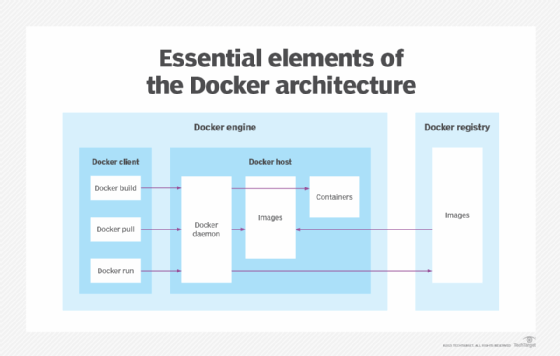
Getty Images
Docker vs. OpenShift: What are the main differences?
Docker and OpenShift have their strengths and weaknesses, and the choice between the two depends on the specific needs of your application and organization.
An organization looking to adopt containerization has many options -- so many, in fact, that the choices and comparisons can become quite confusing. Docker and OpenShift offer features that simplify containerized application deployment and scaling.
By carefully evaluating the features and capabilities of both tools, developers and testers can choose the best one for their container strategy and ensure the success of their containerized application deployments.
What is Docker?
Docker is well known and has long been the standard tool for containerization. Docker packages applications in their own fully functional OSes. To make this self-contained application, a Dockerfile is first created, which specifies a base image, dependencies and the necessary steps to set up, build and run the application. This Dockerfile is simply a text file used to write the steps to build the Docker container.
There are several advantages of using Docker over more traditional options, such as VMs. First, Docker is much quicker to build and deploy. Also, the Dockerfile serves as documentation for the application's runtime environment. Finally, Docker is easily reproducible on any system, regardless of OS.
What is OpenShift?
OpenShift, offered by Red Hat, is a container orchestration tool built on top of Kubernetes. Red Hat is commonly known in the open source software world for products such as Red Hat Enterprise Linux (RHEL).
RHEL is a commercial, open source Linux distribution. Businesses use RHEL when they are looking for a stable, well-tested Linux OS with commercial support. RHEL bundles specific versions of other software packages, such as popular programming languages, web servers and database systems.
OpenShift follows the same pattern, packaging Kubernetes with bug fixes, security patches, CI/CD tools and other development tools. Commercial support is also offered for troubleshooting and resolving any issues that come up.
Docker vs. OpenShift: Containerization capabilities
Docker is one of the most popular containerization tools for organizations starting out with containers. There is wide support for running Docker containers on all major cloud providers.
Dev teams might not be as familiar with more specialized tools such as OpenShift, although there is a lot of documentation and commercial support.
Deploying a Docker container to production using Docker alone is uncommon. For this reason, there are many orchestration tools built on top of containers to enable easier deployments, scaling and better security. Docker doesn't support these extra features, so an orchestration tool is often necessary to run an application in a Docker container in production.

Docker vs. OpenShift: CI/CD integration
For organizations that have already dockerized their applications and are looking for a platform to deploy and run them, OpenShift is a great option. OpenShift provides built-in CI/CD capabilities through its integration with Jenkins, GitLab and other CI/CD tools. OpenShift also provides a built-in image registry for storing and sharing Docker images. OpenShift lets users deploy applications from their source code repository, following DevOps best practices.
Docker can be integrated with CI/CD pipelines, using the Docker CLI, but it's a more manual process than using OpenShift integrations with the same tools. Many CI/CD tools have plugins for building Docker images, but the advantage of OpenShift's integrations is that dev teams can manage the entire process of going from a Dockerfile to a deployed production Docker image in the OpenShift ecosystem.
Overall, OpenShift is a more complex platform than Docker, suited for those looking for a container orchestration tool that provides additional features over bare-bones Kubernetes.
Both Docker and OpenShift are powerful tools that can help developers and IT teams run and manage containerized applications. Docker provides a simple and portable containerization platform that can run on any infrastructure, while OpenShift provides additional features and functionality built on top of Kubernetes. Docker is a great choice for developers who need lightweight and flexible containerization, while OpenShift is a good choice for enterprise-scale applications that require advanced features and integration with CI/CD tools.
Matthew Grasberger is a DevOps engineer at Imperfect Foods. He has experience in test automation, DevOps engineering, security automation and open source mobile testing frameworks.








